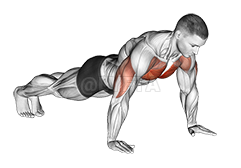
Push-up
Exercise Profile
Related Exercises:
Introduction to the Push-up
Push-ups are a versatile exercise that primarily strengthens the chest, shoulders, and triceps, while also engaging the core and lower body, providing a well-rounded workout. This exercise is suitable for individuals at all fitness levels, with modifications available to increase or decrease difficulty. People would want to do push-ups because they require no equipment, can be done anywhere, and are effective in improving overall body strength and stability.
Performing the: A Step-by-Step Tutorial Push-up
- Keep your feet hip-width apart, engage your core, and maintain a straight line from your head to your feet.
- Begin to lower your body towards the floor by bending your elbows, keeping your elbows close to your body and your back straight.
- Continue to lower yourself until your chest or chin touch the floor, or as close as you can get without compromising your form.
- Push your body up back to the starting position, extending your arms fully, while maintaining the straight line from your head to your feet.
Tips for Performing Push-up
- **Maintain a Straight Body:** Your body should form a straight line from your head to your heels. Avoid letting your back sag or your butt stick up in the air, as these are common mistakes that can lead to back or shoulder injuries. Engage your core to help maintain this position.
- **Full Range of Motion:** Lower your body until your chest nearly touches the floor and then push back up to the starting position. A common mistake is not going low enough or not fully extending the arms at the top. This reduces the effectiveness of the push-up and can even lead to muscle imbalances over time.
- **Controlled Movement:** Avoid rushing the movement. Lower and raise your body in a
Push-up FAQs
Can beginners do the Push-up?
Yes, beginners can definitely do the push-up exercise. However, it may be challenging at first as it requires strength from your arms, shoulders, chest, and core. Beginners can start with modified versions of the push-up, such as knee push-ups or wall push-ups, where you push your body off a wall while standing. As strength and endurance improve, they can gradually progress to regular push-ups. Remember, it's important to maintain proper form to avoid injury.
What are common variations of the Push-up?
- The Wide Grip Push-up involves positioning your hands wider than shoulder-width apart, focusing more on the chest muscles.
- The Decline Push-up is done by placing your feet on an elevated surface, putting more emphasis on the upper chest and shoulders.
- The Spiderman Push-up is a dynamic version where one knee is brought towards the elbow on each rep, engaging the core and hip flexors.
- The Plyometric Push-up, also known as the clapping push-up, involves pushing off the ground with enough force to briefly lift the hands, adding a cardiovascular and power element to the exercise.
What are good complementing exercises for the Push-up?
- Tricep Dips are a great complement to Push-ups because they focus primarily on the triceps and shoulders, enhancing the strength and endurance of these muscles which are crucial for performing effective push-ups.
- Planks complement Push-ups by strengthening the core muscles, which are vital for maintaining proper form during push-ups and improving overall stability and endurance.
Related keywords for Push-up
- Bodyweight chest workout
- Push-up exercise guide
- How to do push-ups
- Chest strengthening exercises
- Bodyweight exercise for chest
- Push-up workout routine
- At-home chest workout
- Push-up technique
- Benefits of push-ups
- Chest muscle building exercises











